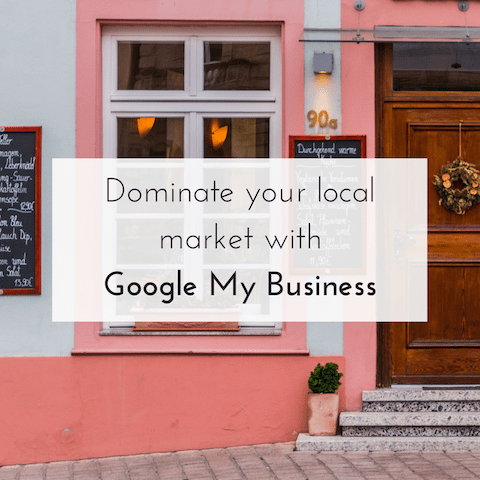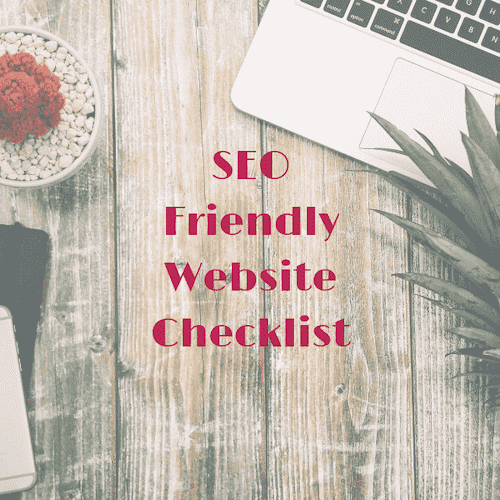
Unfortunately, by simply building a website, this will not guarantee customers will come. Even the most beautiful and technologically advanced websites need help in order for people to find them.
Helping people find your website, can be through search marketing strategies like SEO and Google Ads (aka PPC) alongside traditional marketing methods like adding your website address to business cards and on brochures.
So the question I am posing today is, what does your website need in 2023 to be SEO friendly? Aka what should your website have to entice Google to rank it higher in the SERPs (search engine result pages)?
A SEO friendly website is one which Google ranks highly in the SERPs (search engine result pages) because it deems the website easy to use and full of useful, relevant information for people.
Here’s my 2023 checklist for an SEO friendly website:
- An XML sitemap
- An HTML sitemap / navigational page for users
- Block pages you don’t want to show on the search result pages with robots.txt or ‘noindex meta tags’
- Every page should have an editable meta title and description field where you can create unique page titles and meta descriptions
- Every page should use heading tags to emphasize important text (the main heading on a page should be an h1 heading, followed by h2, h3, h4 to show content hierarchy)
- Structured data markup
- Keep your website URLs clean, short and use subfolders to organise content
- Add breadcrumbs
- Fast loading webpages
- Mobile -friendly webpages
- A secure HTTPS website
- Website and conversion tracking (including eCommerce tracking for online shops)
- Make your website content interesting and useful
- Text should be easy to read
- Act in a way that cultivates user trust
- Make expertise and authoritativeness clear
- Provide an appropriate amount of content for your subject
- Avoid distracting advertisements
- Add internal links and use link text wisely – e.g. learn more about search engine optimisation here
- Ensure images are optimised (small file sizes, relevant file names and alt text)
- Consider voice search
XML sitemap
An XML sitemap is for search engines to read. Your website visitors shouldn’t see this page (so there’s no need to link to it from your website) however you should add the URL to your XML sitemap in your Google Search Console account.
“A sitemap is a file on your site that tells search engines about new or changed pages on your site” – Google.
For example, here is my XML sitemap: grandcrudigital.com.au/sitemap.xml
HTML sitemap
Your website should have an HTML sitemap. This is a navigational page for your website visitors. Typically you’ll find this sitemap linked to in the footer of the website and it’s a page which lists all of your key pages on your website. See my HTML sitemap here.
This page should automatically update as you add/remove pages to avoid any broken links / any outdated content.
“Include a simple navigational page for your entire site (or the most important pages, if you have hundreds or thousands) for users.” – Google
Fast Website Speed
The need for speed is key. Google has stated that 53% of websites are abandoned if a mobile site takes longer than 3 seconds to load.
Yes mobile is massive, but don’t forget about desktop or tablet users either. It’s important your website loads as quickly as possible on all devices. People are becoming more and more impatient. Think about what you do if a web page takes a long time to load… You’d hit the back button, wouldn’t you?
When I was creating this website for Grand Cru Digital, my number one focus was getting the speed spot on. Improving website speed was an investment I was willing to make as I know it’ll bring return on investment.
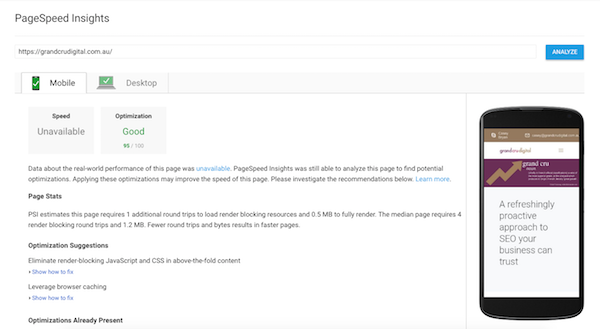
Google has announced the importance of speed this year with the confirmation of the “Speed Update” rolling out in July 2018. Website speed has always been a ranking factor for desktop websites, however, this update will now take into consideration your mobile website speed.
The “Speed Update,” as we’re calling it, will only affect pages that deliver the slowest experience to users and will only affect a small percentage of queries. It applies the same standard to all pages, regardless of the technology used to build the page. The intent of the search query is still a very strong signal, so a slow page may still rank highly if it has great, relevant content.
As you can see it’s important, however, we still get told the same very important message which is the core of SEO – the website which answers a searcher’s query the best, will be ranked at the top of the search results. There’s no cheating, you’ve just got to be bloody good at what you do and produce great content.
A Mobile-Friendly Website
After reading the above, this should really be a given. Your website needs to look good and function well on mobile devices.
According to Global Stats Counter, mobile currently accounts for 51.43% share of online activity.
When we talk about mobile-friendless we want mobile websites to be:
| • | Fast loading |
| • | Easy to navigate. E.g. the buttons and menu options should be big enough that you don’t accidentally hit other options (even if you have sausage fingers) |
| • | Easy to use. E.g. please avoid things like pop-ups on mobile, they put hurdles in the way for user-experience (and in my opinion, you should just avoid them altogether) |
You can check your website for mobile friendless through tools like:
| • | Test my Site – Think With Google |
| • | Google Mobile-Friendly Test |
Plus there is also plenty of information via the above links to let you know what you need to do to improve your mobile website to make it more SEO friendly.
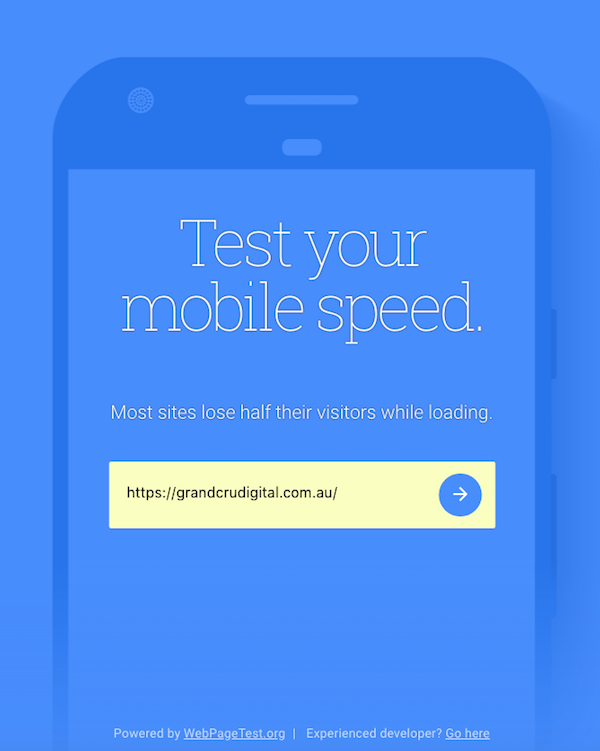
Bonus tip: It’s also worth considering AMP (accelerated mobile pages) which I implemented on travellingcorkscrew.com.au about a year ago. These lighting-fast pages are a hot topic in Google and SEO circles. They don’t suit every website and every web page, but it’s a topic worth speaking to your SEO specialist and web developer about. AMPs are particularly good for blogs.
A Secure HTTPS Website
Migrating your website from HTTP to HTTPS has to happen sooner or later. It’s a step towards making the internet a safer place.
Making the move, doesn’t necessarily cost money if you opt for a free SSL certificate and do the migration yourself. However I would highly recommend speaking to your web developer and/or hosting company who will advise you.
It’s also highly recommended to get advice from a SEO consultant who will ensure HTTPS implementation Google Best Practices are met and your website visitors from Google aren’t impacted too much. If SEO is not considered during the migration, you can see a quick drop in website traffic and keyword rankings.
Click here for more details on securing your website and migrating to HTTPS.
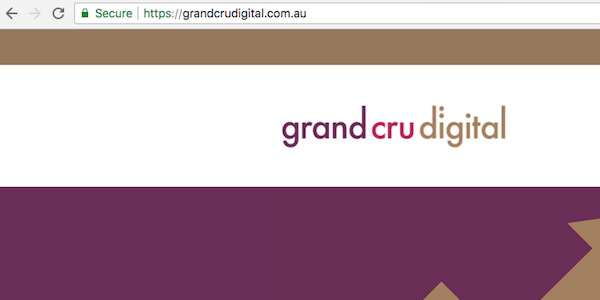
Consider Voice Search
It’s a thing! No longer are we simply typing something into Google, but we are literally asking Google and various other devices to find and do stuff for us.
When we say ‘voice search’ we are talking about when you ask Siri to look for something on the web, or you say ‘Hey Google, what should I cook tonight’.
With the likes of Google Assistant and Google Home, Amazon Echo/Alexa and Siri on iPhone to name a few, voice search is a thing all SEO specialists and website owners need to consider.
It might not impact all websites and businesses, but it’s worth asking the question to your website team.
If you feel you have content which might be verbally searched for by people, then consider adding things like FAQs (frequently asked questions) to your website, use a conversationalist tone in your website copy and add structured data (see more on this below).
Add Structured Data
Please don’t glaze over this one, just because we are speaking about code. It is super important as it’s a way to speak directly to Google.
By putting certain code around specific elements on your website, it’ll tell Google exactly what it is. Items I tend to recommend to add structured data (also called in-page markup) to are; contact details, breadcrumbs and blog posts.
Depending on your industry and niche, there may be other markups you want to use. I would highly recommend you, your SEO consultant or web developer, check out schema.org.
The best type of schema to implement for Google is JSON-LD which Google provides advice on implementation via their developer support pages.
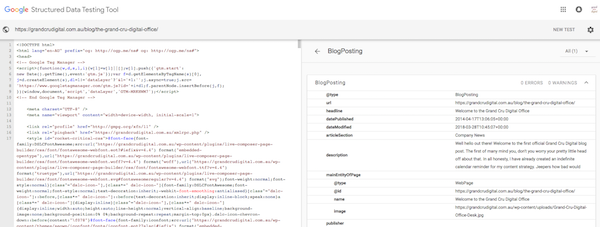
Add Website & Conversion Tracking
This is definitely not a new tip. If you want to get more visitors to your website, you need to first know who is coming to your website, from where and how they are interacting with your web pages.
Free tools like Google Analytics can do this for you.
Through this tool you can also track certain interactions (or as we call them ‘conversions’) with your website, such as when someone;
| • | Fills in and submits a form |
| • | Makes a purchase |
| • | Clicks on your phone number or email address |
| • | Watches a video |
| • | Downloads a PDF or brochure |
| • | Clicks through to your social media pages |
| • | Spends longer than 2 minutes on your web page |
The list of actions you can track is pretty much endless. The key is, to track, analyse and then strategise. With the end goal of getting more converting website visitors. The more you get, the more money your business will make.
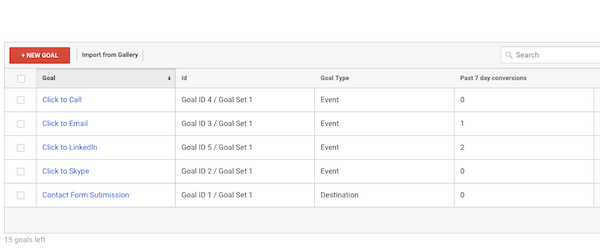
Awesome Website Content
This is a constant preach of mine. High quality, unique content is imperative to succeeding online.
What does Google want to do? It wants to provide users with great content that answers their queries (more on search intent below). It wants to provide fresh, relevant content daily.
So what’s the best way to do that? Well other than speaking to Grand Cru Digital about their content writing and strategy services, you need to be adding good quality content to your website regularly. This content should be of interest to your current and potential customers.
You’ll get even more benefits out of your content if you can attract other people and influencers on the web who will then share and link to your content. This will benefit your SEO efforts extremely.
Understanding Searcher Intent
Before you create content you need to understand the user a little bit better.
But how do you understand a potential customer you know nothing about? That’s where understanding searcher intent comes in.
Searcher intent is understanding what type of content and information someone is looking for when they type a phrase into Google. For instance:
If someone is searching for ‘DIY fix garage door’ then they are most likely looking for a step-by-step guide on trying to fix their garage door themselves (or better yet, a YouTube video) rather than a web page which is selling garage doors. Therefore a wikiHow page will be ranked higher than Joe’s Garage Doors page.
Searcher intent is about getting into the head of searchers and thinking, ‘if I typed that keyword phrase into Google, what result would I want to see’, and then crafting content around that.
Determine if you Need SEO & its Priority
With the internet taking over, and more and more businesses focusing their marketing budgets on digital marketing, it’s important you work out if you need SEO and its priority for your business.
I recently had someone ask me, how do I work out if SEO is feasible for their business, e.g. will it bring a return on investment?
My answer was, let me do some preliminary research and get back to you. During this phase, I did some keyword research and looked at various stats for their industry and how other businesses are partaking in online marketing.
It was no surprise to me, that yes, there are 100s of people searching for relevant keyword terms that are looking for businesses like theirs. From that point, we then worked out a strategy which would fit their business and budget.
At Grand Cru Digital, we are selective with the businesses we work with. Firstly, we want to work with businesses who have similar values to us and secondly, we want to work with businesses we know we can help improve their website and get results for.
If there’s no online demand for your products/services, then we will suggest other marketing ideas you can consider.
In Conclusion
At the end of the day, my biggest tip is to think about your customers and potential customers. I am pretty sure most internet users, like you and me want:
| • | A website that loads fast |
| • | A website they can access on their mobile phone |
| • | A safe to use website |
| • | A website that can be found on Google |
| • | Great content that answers our needs and wants |
If you need help making your website user and SEO friendly, don’t hesitate to contact Grand Cru Digital today for a chat about what will work best for you.





